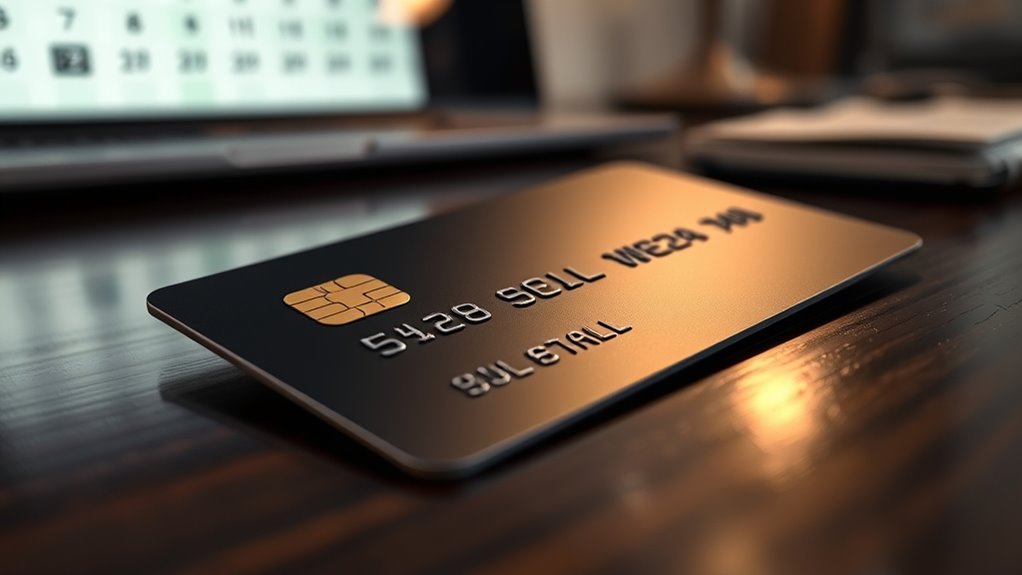A credit card grace period is a window of time—usually between 21 and 25 days—when you can make new purchases interest-free. To qualify, you need to pay your previous statement’s balance in full by the due date and keep your account in good standing. If you pay on time, your new purchases stay interest-free during this period. Keep in mind, not all transactions qualify, so it’s helpful to understand your card’s policies for full benefit.
Key Takeaways
- A credit card grace period is the time between the statement date and due date to pay purchases without interest.
- It typically lasts between 21 and 25 days, during which paying in full avoids interest charges.
- To qualify, you must pay your previous statement’s balance in full and keep your account in good standing.
- Cash advances and balance transfers usually do not have a grace period and accrue interest immediately.
- Missing the due date or carrying a balance from previous months can eliminate the grace period benefits.

Have you ever wondered how you can avoid paying interest on your credit card purchases? Understanding your credit card’s grace period is key to doing just that. The grace period is the window of time during which you can pay off your new purchases without incurring interest. It typically starts from the day your statement is issued and lasts until the payment due date. During this period, if you pay your balance in full, you can enjoy an interest-free period on your purchases. This is a great way to manage your finances and avoid unnecessary costs, but it hinges on your payment timing.
Your credit card issuer generally requires you to pay your previous statement’s balance in full to qualify for the interest-free period on new purchases. If you carry a balance from month to month, you might lose this benefit, and new purchases could start accruing interest immediately. This means that the timing of your payments is essential. Making your payment before the due date ensures you’re within the interest-free period, saving you money. Conversely, missing the due date or only making a partial payment can result in interest charges on your entire balance, including new purchases.
The interest-free period is most advantageous when you pay your full statement balance by the due date. When you do this, the credit card company considers your account current, resets the billing cycle, and gives you a fresh window during which you won’t be charged interest on new purchases. This period usually lasts between 21 and 25 days, depending on your card issuer and billing cycle. To maximize this benefit, it’s vital to track your payment timing carefully. Setting reminders or automatic payments can help ensure you don’t miss the deadline and forfeit the grace period.
Keep in mind that not all transactions qualify for the interest-free period. Cash advances and balance transfers, for example, often start accruing interest immediately, regardless of your payment timing. Also, if you make a purchase after paying your previous balance, the new purchase might not be covered by the current grace period, especially if your account is not paid in full. So, it’s important to understand your specific credit card’s policies. Additionally, understanding the use of wall organization systems can help you keep track of your finances and statements efficiently.
Frequently Asked Questions
Does the Grace Period Apply to Cash Advances?
No, the grace period usually doesn’t apply to cash advances. When you take a cash advance, you typically start accruing interest immediately, and there’s no interest-free period. Cash advance fees also apply, and interest calculation begins right away, often at a higher rate. So, it’s wise to pay off cash advances quickly to avoid extra charges, since the grace period isn’t available for these transactions.
Can I Have a Grace Period With a New Credit Card?
Think of a new credit card’s grace period as a fresh start—yes, you can enjoy it if you pay your balance in full each month. This benefit allows you to avoid interest on purchases if you stick to the payment timing. Keep in mind, some cards might not offer a grace period immediately, but understanding your card’s benefits helps you make the most of your payment schedule and save money.
What Happens if I Miss My Payment During the Grace Period?
If you miss your payment during the grace period, you’ll likely face a late fee, which can increase your bill. Additionally, your credit impact may worsen because missed payments are reported to credit bureaus, potentially lowering your credit score. To avoid these consequences, try to pay before the grace period ends, ensuring you stay on top of your payments and maintain a healthy credit profile.
Does the Grace Period Vary Between Credit Card Issuers?
The grace period varies between credit card issuers like a snowflake’s unique pattern. Some offer a longer window, while others have shorter periods. This affects how quickly interest rates kick in if you don’t pay on time, and it influences your credit reporting, too. Always check your card’s terms to understand your specific grace period, so you can manage your payments effectively and avoid unnecessary interest charges or negative credit impacts.
How Is the Grace Period Affected by Balance Transfers?
Balance transfers can affect your grace period because most issuers don’t offer one on transferred balances, leading to interest accrual from the transfer date. While balance transfer benefits include potentially lower interest rates, you might lose your grace period if you don’t pay the transferred amount in full each month. To maximize your benefits, pay off transferred balances promptly, avoiding interest charges and making the most of your card’s features.
Conclusion
Now that you know about the credit card grace period, imagine what could happen if you ignore it—interest piling up like a mountain, fees exploding like fireworks, and your credit score plummeting faster than a skydiver without a parachute. But if you pay on time, you’ll glide smoothly through your financial journey, avoiding chaos and keeping your credit score soaring like an eagle. Don’t let that tiny window turn into a financial disaster—stay vigilant!









